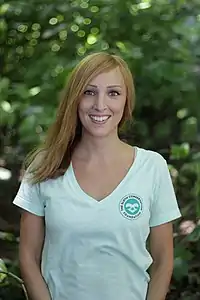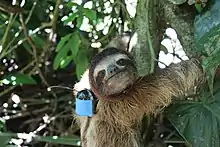Rebecca Cliffe | |
|---|---|
 | |
| Born | May 15, 1990 |
| Education | BA 2012; PhD 2017 |
| Alma mater | University of Manchester, Swansea University |
| Occupation(s) | zoologist, conservation biologist |
Rebecca Cliffe (born May 15, 1990) is a British zoologist and one of the leading experts on sloth biology and ecology.[1][2] She is the Founder and Executive Director of The Sloth Conservation Foundation and author of the book Sloths: Life in the Slow Lane with photographs by award-winning wildlife photographer Suzi Eszterhas.[3][4]
Early years and work

Cliffe was born in 1990 in Preston, England. Cliffe received her bachelor’s degree in Zoology from the University of Manchester. She later went on to obtain a PhD in Bioscience (specializing in sloths) from Swansea University.[5] As part of her PhD research, she conducted the longest recorded study on wild sloth ecology (The Sloth Backpack Project).[6][7]
She has published various studies on the ecology, biology, and physiology of sloths which have provided new insights about these poorly understood species.[8][9][10][11] Due to her in-depth research and first-hand observations in the field she is considered to be an expert on sloths and their behavior.[12][13][14][15]
She was featured in the Discovery Channel series “Meet the Sloths.”[16][17] She also was a part of the documentary "72 Dangerous Animals: Latin America” and featured in Animal Planet’s “Too Cute! Baby Sloths.”[18][19]
Recent work
In 2017, Cliffe founded The Sloth Conservation Foundation a registered non-profit organisation that is dedicated to saving sloths in the wild and has served as Executive Director since its inception.[20] She continues to publish research on the biology, ecology and physiology of sloths.[21][22][23][24][25]
References
- ↑ Dowling, Stephen. "Why do sloths move so slowly?". www.bbc.com. Retrieved 2020-07-22.
- ↑ Turner, Robin (2013-10-13). "Welsh 'sloth woman of Costa Rica' enjoys Lara Croft-like existence". walesonline. Retrieved 2020-07-22.
- ↑ "Dr Rebecca Cliffe of Penwortham reveals all about working in the jungle in her book Sloths: Life in the Slow Lane". www.lep.co.uk. Retrieved 2020-07-22.
- ↑ "Wildlife Photographer of the Year: a baby beaver given a fighting chance". www.nhm.ac.uk. Retrieved 2020-07-22.
- ↑ Nicholls, Henry. "The truth about sloths". www.bbc.com. Retrieved 2020-07-22.
- ↑ olsone, Eric R. Olson |. "Why Are These Sloths Wearing Tiny Backpacks? | Blog | Nature | PBS". Nature. Retrieved 2020-07-22.
- ↑ "Dr Rebecca Cliffe of Penwortham reveals all about working in the jungle in her book Sloths: Life in the Slow Lane". www.lep.co.uk. Retrieved 2020-07-22.
- ↑ Cliffe, Rebecca N.; Haupt, Ryan J.; Avey-Arroyo, Judy A.; Wilson, Rory P. (2015). "Sloths like it hot: ambient temperature modulates food intake in the brown-throated sloth (Bradypus variegatus)". PeerJ. 3: e875. doi:10.7717/peerj.875. ISSN 2167-8359. PMC 4389270. PMID 25861559.
- ↑ Cliffe, Rebecca N.; Avey-Arroyo, Judy A.; Arroyo, Francisco J.; Holton, Mark D.; Wilson, Rory P. (2014-04-30). "Mitigating the squash effect: sloths breathe easily upside down". Biology Letters. 10 (4): 20140172. doi:10.1098/rsbl.2014.0172. PMC 4013704. PMID 24759371.
- ↑ Ishibashi, Shoko; Cliffe, Rebecca; Amaya, Enrique (2012-12-15). "Highly efficient bi-allelic mutation rates using TALENs in Xenopus tropicalis". Biology Open. 1 (12): 1273–1276. doi:10.1242/bio.20123228. ISSN 2046-6390. PMC 3558749. PMID 23408158.
- ↑ Cliffe, Rebecca N.; Haupt, Ryan J.; Avey-Arroyo, Judy A.; Wilson, Rory P. (2015-04-02). "Sloths like it hot: ambient temperature modulates food intake in the brown-throated sloth (Bradypus variegatus)". PeerJ. 3: e875. doi:10.7717/peerj.875. ISSN 2167-8359. PMC 4389270. PMID 25861559.
- ↑ Schardt, Hannah. "Spying on Sloths" (PDF). National Wildlife Federation.
- ↑ Manaster, Joanne. "Lucky Field Researcher Witnesses Birth of Sloth! Happy International Day of the Sloth!". Scientific American Blog Network. Retrieved 2020-07-22.
- ↑ "Audio: Debunking myths about sloths is crucial to stopping the sloth crisis". Mongabay Environmental News. 2019-04-02. Retrieved 2020-07-22.
- ↑ Dominic Rech (3 March 2020). "A rare video captured the heart-stopping moment a sloth gave birth in a tree". CNN. Retrieved 2020-07-22.
- ↑ "Meet The Sloths". Discovery UK. Retrieved 2020-07-22.
- ↑ Galeazzi, Linda (2018-12-12). "Dream Job Alert: Becky Cliffe Is Saving Sloths For A Living". Faze. Retrieved 2020-07-22.
- ↑ The Freaks, retrieved 2020-07-22
- ↑ "Too Cute! | Watch Full Episodes & More!". Animal Planet. Retrieved 2020-07-22.
- ↑ "BBC Radio 4 - Radio 4 in Four - 10 incredible facts about the sloth". BBC. Retrieved 2020-07-22.
- ↑ @NatGeoUK (2018-10-01). "Sloths Act Like Birds and Reptiles in This Bizarre Way". National Geographic. Retrieved 2020-07-22.
- ↑ Solly, Meilan. "Sloths Don't Just Live in Slow-Mo, They Can Put Their Metabolism On Pause". Smithsonian Magazine. Retrieved 2020-07-22.
- ↑ Olson, Rachel A.; Glenn, Zachary D.; Cliffe, Rebecca N.; Butcher, Michael T. (2018-12-01). "Architectural Properties of Sloth Forelimb Muscles (Pilosa: Bradypodidae)". Journal of Mammalian Evolution. 25 (4): 573–588. doi:10.1007/s10914-017-9411-z. ISSN 1573-7055. S2CID 22238582.
- ↑ Cliffe, Rebecca Naomi; Scantlebury, David Michael; Kennedy, Sarah Jane; Avey-Arroyo, Judy; Mindich, Daniel; Wilson, Rory Paul (2018-09-19). "The metabolic response of the Bradypus sloth to temperature". PeerJ. 6: e5600. doi:10.7717/peerj.5600. ISSN 2167-8359. PMC 6151113. PMID 30258712.
- ↑ Spainhower, Kyle B.; Cliffe, Rebecca N.; Metz, Allan K.; Barkett, Ernest M.; Kiraly, Paije M.; Thomas, Dylan R.; Kennedy, Sarah J.; Avey-Arroyo, Judy A.; Butcher, Michael T. (2018-05-03). "Cheap labor: myosin fiber type expression and enzyme activity in the forelimb musculature of sloths (Pilosa: Xenarthra)". Journal of Applied Physiology. 125 (3): 799–811. doi:10.1152/japplphysiol.01118.2017. ISSN 8750-7587. PMID 29722617.